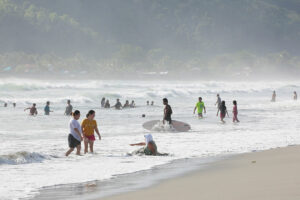LEGISLATORS preparing the 2023 budget said the Department of Tourism (DoT), which will receive 30% more funding under the spending plan proposed by the Executive branch, is still inadequately funded relative to the economic benefits generated by the industry it regulates.
“As revenue and job-generating department, adequate budgetary support must be accorded to the Department of Tourism so that the Philippines can compete for tourist arrivals with our ASEAN neighbors and create local livelihood opportunities,” Albay Rep. Edcel C. Lagman said at a hearing of the House Committee on Appropriations.
The 2023 DoT budget is P3.58 billion, up 30.3%, according to the spending plan sent by the government to Congress. The department had sought funding of P12.2 billion from the Department of Budget and Management.
Zamboanga Sibugay Rep. Wilter Y. Palma told the committee that he “fully endorse(s) the augmentation or the increase of the budget of the Department of Tourism” because its funding, as proposed, “is small compared to the income that is being derived from the tourism industry.”
Manila Rep. Edward Vera P. Maceda said that even with small budgets, the department must improve its fund utilization.
President Ferdinand R. Marcos, Jr., in his First State of the Nation Address to lay out his legislative agenda, called tourism “an important economic development tool” that generates an “abundance of opportunities… in terms of regular employment and even job creation at the grassroots level.”
Gabriela Party-list Rep. Arlene D. Brosas said the DoT does not appear to have allocated funds for safety nets, wage subsidies, or cash assistance for tourism workers, who were among the most affected by the pandemic.
Tourism Secretary Ma. Esperanza Christina G. Frasco told the committee that the department “signed a Memorandum of Understanding with the Department of Labor and Employment (DoLE) with a view to bridging the gap between the shortage of workers in the accommodation sector, as well as the huge demand for tourism employment, especially for those who have been displaced by the pandemic and those who wish to pursue a career in tourism.”
She said the current tourism workforce is up 4.6% from the 2021 work force of 4.7 million.
Ms. Frasco added that the DoT is organizing its efforts around attracting long-stay, repeat visitors.
John Paolo R. Rivera, associate director of the Asian Institute of Management Dr. Andrew L. Tan Center for Tourism, said tourism’s employment potential rests on the increasing confidence of travelers as borders and economies reopen.
“As we transition to post-pandemic (conditions), the demand for tourism products and services will increase, (generating) a need for the workforce to service rising demand,” Mr. Rivera said in an e-mail.
In other committee work at the House, the Committee on Micro, Small, and Medium Enterprise Development, said its agenda is headlined by the proposed Magna Carta for Micro-, Small- and Medium-Sized Enterprises (MSMEs), the proposed Pondo sa Pagbabago At Pag-asenso (P3) act, the proposed Barangay Microfinance System act, the proposed Strengthening the Protection & Welfare of Self-Employed Workers act, the proposed Establishment of Support Services for Small Entrepreneurs in Online Spaces act, the proposed Declaration of National Entrepreneurship Week act, the proposed MSME Stimulus Act, the proposed Pangkabuhayan Act of 2022, a measure setting up a Small- and Medium-sized Enterprises stock exchange, and amendments to the Go Negosyo Act.
It said 24 bills have been referred to the committee as of Aug. 17. — Kyanna Angela Bulan
